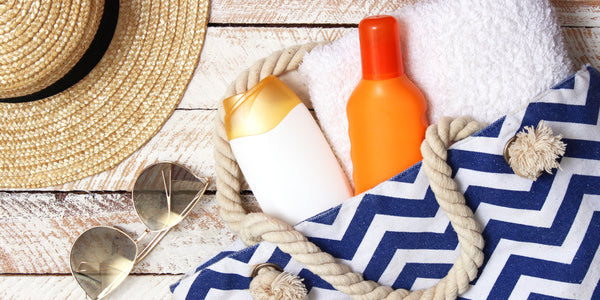
Skin cancer becomes a concern for many people while they catch some rays. But we break down the myths and facts you need to know before you get ready to relax for some fun in the sun.
We put some of the biggest summer myths about the sun under the spotlight and give you the bottom line on how you can protect yourself, and prevent yourself, from increasing your chances of skin cancer.
What Is Skin Cancer?
According to the Skin Cancer Foundation, skin cancer is "the uncontrolled growth of abnormal skin cells. It occurs when unrepaired DNA damage to skin cells (most often caused by UV radiation from sunshine or tanning beds) triggers mutations, or genetic defects, that lead the skin cells to multiply rapidly and form malignant tumors."
But explaining skin cancer is broad, as there are multiple forms of skin cancer and precancers. These include:
• Actinic keratosis
• Atypical moles
• Basal cell carcinoma
• Melanoma
• Merkel cell carcinoma
• Squamous cell carcinoma
Out of the types of skin cancer, melanoma is expressed to be less common compared to others. However, it is considered the most dangerous for and kills an estimated 10,130 of Americans each year.
Often resembling or developing from moles, it is mainly caused by intense, occasional UV exposure (mostly leading to sunburn), especially in individuals who are genetically predisposed.
Beyond sun exposure and genetics, the following factors increase the risk of melanoma and other skin cancers:
• Gender
• Having a number of skin moles
• Skin type, though all even dark-skinned people can develop skin cancer
• Family history
• A weakened immune system
• Smoking
What's more, skin cancer facts and statistics are quite alarming. The Skin Cancer Foundation reports:
• More than 9,500 people are diagnosed with skin cancer in the United States every day. More than two people die with the disease every hour.
• More people are diagnosed with skin cancer each year in the U.S. than all other cancers combined.
• More than 5.4 million cases of nonmelanoma skin cancer were treated in over 3.3 million people in the U.S. in 2012.
• One in five Americans will develop skin cancer by the age of 70.
With such overwhelming statistics, it is important to dispel myths and get the facts on such a deadly, yet preventable disease.
Skin Cancer Myth 1: Sunless Tanning Products Protect From Sun Damage
Self-tanners are promoted to be a great alternative to bronzing the skin. But the only thing self-tanners do is stain the top layer of the skin with a bronze color. This means they are devoid of any sort of SPF and should not be used to protect from the sun.
Besides, dihydroxyacetone (DHA) is often an active ingredient in sunless tanning products. DHA may cause cell damage via free radical reactions. Luckily companies continue to produce safer products lacking in DHA.
The bottom line: When in doubt, always wear sunscreen and look for more natural products. Your health will thank you for it later!
Skin Cancer Myth 2: Vitamin D Deficiency Caused by Sunscreen
Vitamin D is a unique nutrient, as it can be supplied through sunlight. This makes people speculate sunscreen can lower vitamin D levels.
But using sunscreen will not cut the body's production of vitamin D. Ultimately, it is better to protect yourself with enough sunscreen, as too many UV rays can cause the skin to break down vitamin D.
And instead of relying solely on the sun for vitamin D, eat foods that supply the vitamin D. Salmon, egg yolks, and mushrooms all naturally source the vitamin. Fortified foods, including cereal, milk, and orange juice, tend to be great sources of vitamin D as well.
The bottom line: Sunscreen will not cause a vitamin D deficiency. It will, though, be useful for protecting the skin from UV damage.
Skin Cancer Myth 3: The Higher SPF, the Better
While this myth makes sense in theory, a higher SPF does not mean automatically mean more sun protection. In a nutshell, UVA is what makes the skin age and UVB is what burns the skin.
SPF stands for "sun protection factor" and measures how well the sunscreen protects from UVB. SPF 15 protects against 93 percent of UVB, SPF 30 protects against 97 percent, and SPF 50 protects against 98 percent.
Whereas higher SPFs offer more protection, they may come with a false sense of security. People using higher SPFs may feel as if they do not need to reapply, which is not the case.
Here is a roadmap about the truth on SPF and tips for application:
• Adults should wear a sunscreen with no less than an SPF 15 according to the FDA. However, the American Academy of Dermatology (AAD) advises adults and children should wear an SPF of at least 30.
• Sunscreens should be broad-spectrum. This means they have the ability to protect against both UVA and UVB.
• Buy and use water-resistant sunscreen, especially if planning to get in the water. Reapply sunscreen every 80 minutes or so.
• Cover the body 30 minutes prior to sun exposure and every two to four hours of outdoor activity. One ounce, or the size of a shot glass, is considered the safe amount of sunscreen needed to cover exposed areas of the body.
The bottom line: Just because a sunscreen has a higher SPF, does not mean it does a better job at blocking UV damage and protecting your skin.
All-in-all, practice safe sunning to reduce the risk of developing skin cancer. This can include limiting sun exposure as well, especially when the sun's rays are usually strongest between 10 a.m. and 4 p.m.
Also, forego the tanning beds. If desiring a base tan, consider using a sunless tanner without DHA as its active ingredient.







